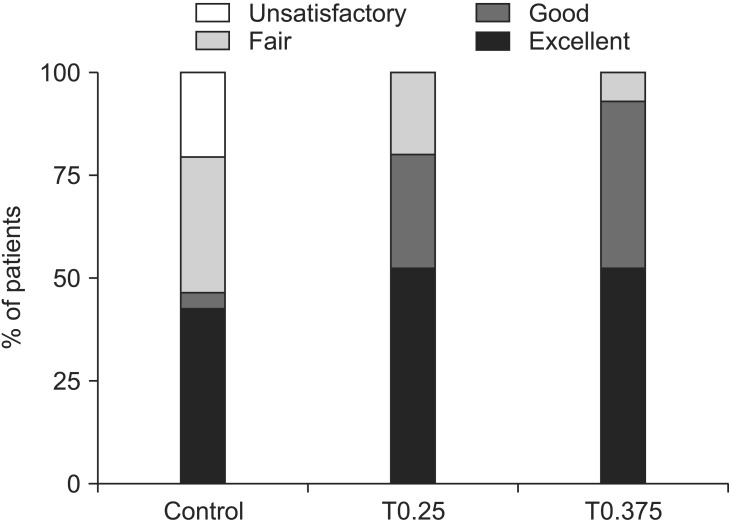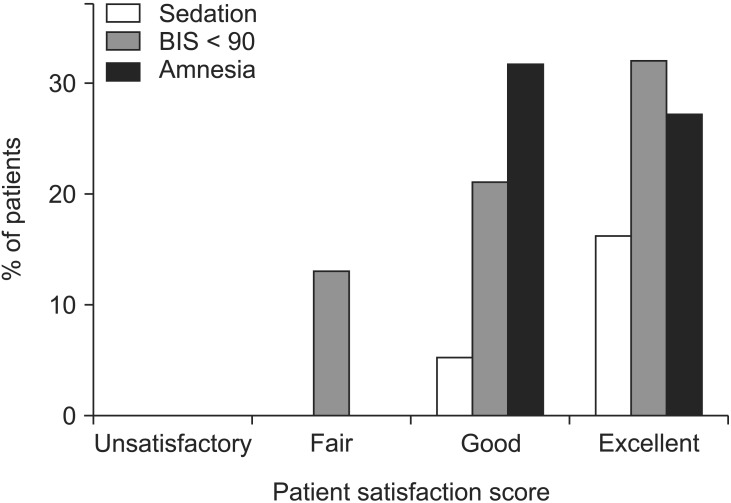1. Mavridou P, Dimitriou V, Manataki A, Arnaoutoglou E, Papadopoulos G. Patient's anxiety and fear of anesthesia: effect of gender, age, education, and previous experience of anesthesia. A survey of 400 patients. J Anesth. 2013; 27:104–108. PMID:
22864564.

2. Johnston M. Pre-operative emotional states and post-operative recovery. Adv Psychosom Med. 1986; 15:1–22.

3. Kain ZN, Sevarino F, Pincus S, Alexander GM, Wang SM, Ayoub C, et al. Attenuation of the preoperative stress response with midazolam: effects on postoperative outcomes. Anesthesiology. 2000; 93:141–147. PMID:
10861157.
4. Sheen MJ, Chang FL, Ho ST. Anesthetic premedication: new horizons of an old practice. Acta Anaesthesiol Taiwan. 2014; 52:134–142. PMID:
25304317.

5. Dionne RA, Goldstein DS, Wirdzek PR. Effects of diazepam premedication and epinephrine-containing local anesthetic on cardiovascular and plasma catecholamine responses to oral surgery. Anesth Analg. 1984; 63:640–646. PMID:
6731889.

6. Abdul-Latif MS, Putland AJ, McCluskey A, Meadows DP, Remington SA. Oral midazolam premedication for day case breast surgery, a randomised prospective double-blind placebo-controlled study. Anaesthesia. 2001; 56:990–994. PMID:
11576102.

7. Bauer KP, Dom PM, Ramirez AM, O'Flaherty JE. Preoperative intravenous midazolam: benefits beyond anxiolysis. J Clin Anesth. 2004; 16:177–183. PMID:
15217656.

8. Kain ZN, Mayes LC, Bell C, Weisman S, Hofstadter MB, Rimar S. Premedication in the United States: a status report. Anesth Analg. 1997; 84:427–432. PMID:
9024042.
9. Stopperich PS, Moore PA, Finder RL, McGirl BE, Weyant RJ. Oral triazolam pretreatment for intravenous sedation. Anesth Prog. 1993; 40:117–121. PMID:
7943920.
10. Lieblich SE, Horswell B. Attenuation of anxiety in ambulatory oral surgery patients with oral triazolam. J Oral Maxillofac Surg. 1991; 49:792–796. PMID:
2072190.

11. Pinnock CA, Fell D, Hunt PC, Miller R, Smith G. A comparison of triazolam and diazepam as premedication agents for minor gynaecological surgery. Anaesthesia. 1985; 40:324–328. PMID:
2860819.

12. Baughman VL, Becker GL, Ryan CM, Glaser M, Abenstein JP. Effectiveness of triazolam, diazepam, and placebo as preanesthetic medications. Anesthesiology. 1989; 71:196–200. PMID:
2667400.

13. Kim D, Lee S, Pyeon T, Jeong S. Use of triazolam and alprazolam as premedication for general anesthesia. Korean J Anesthesiol. 2015; 68:346–351. PMID:
26257846.

14. Mandrioli R, Mercolini L, Raggi MA. Benzodiazepine metabolism: an analytical perspective. Curr Drug Metab. 2008; 9:827–844. PMID:
18855614.

15. Zaider TI, Heimberg RG, Fresco DM, Schneier FR, Liebowitz MR. Evaluation of the clinical global impression scale among individuals with social anxiety disorder. Psychol Med. 2003; 33:611–622. PMID:
12785463.

16. Hindmarch I. Psychomotor function and psychoactive drugs. 1980. Br J Clin Pharmacol. 2004; 58:S720–S740. PMID:
15595961.
17. Eberts FS Jr, Philopoulos Y, Reineke LM, Vliek RW. Triazolam disposition. Clin Pharmacol Ther. 1981; 29:81–93. PMID:
6109586.

18. Ehrich DG, Lundgren JP, Dionne RA, Nicoll BK, Hutter JW. Comparison of triazolam, diazepam, and placebo as outpatient oral premedication for endodontic patients. J Endod. 1997; 23:181–184. PMID:
9594761.

19. Longbottom RT, Pleuvry BJ. Respiratory and sedative effects of triazolam in volunteers. Br J Anaesth. 1984; 56:179–185. PMID:
6140935.

20. Scheinin M, Scheinin H, Ekblad U, Kanto J. Biological correlates of mental stress related to anticipated caesarean section. Acta Anaesthesiol Scand. 1990; 34:640–644. PMID:
1703380.

21. Gras S, Servin F, Bedairia E, Montravers P, Desmonts JM, Longrois D, et al. The effect of preoperative heart rate and anxiety on the propofol dose required for loss of consciousness. Anesth Analg. 2010; 110:89–93. PMID:
19910628.

22. Chen XK, Zhou YP, Zhang X, Xia LP, Li AF, Liu H, et al. Conscious sedation with midazolam and dezocine for diagnostic flexible bronchoscopy. Eur Rev Med Pharmacol Sci. 2015; 19:3688–3692. PMID:
26502859.
23. Maltais F, Laberge F, Laviolette M. A randomized, double-blind, placebo-controlled study of lorazepam as premedication for bronchoscopy. Chest. 1996; 109:1195–1198. PMID:
8625666.

24. Greenblatt DJ, Harmatz JS, Shapiro L, Engelhardt N, Gouthro TA, Shader RI. Sensitivity to triazolam in the elderly. N Engl J Med. 1991; 324:1691–1698. PMID:
2034245.

25. Bakti G, Fisch HU, Karlaganis G, Minder C, Bircher J. Mechanism of the excessive sedative response of cirrhotics to benzodiazepines: model experiments with triazolam. Hepatology. 1987; 7:629–638. PMID:
3610043.

26. Grant MC, Kim J, Page AJ, Hobson D, Wick E, Wu CL. The effect of intravenous midazolam on postoperative nausea and vomiting: a meta-analysis. Anesth Analg. 2016; 122:656–663. PMID:
26332858.
27. Khalil SN, Berry JM, Howard G, Lawson K, Hanis C, Mazow ML, et al. The antiemetic effect of lorazepam after outpatient strabismus surgery in children. Anesthesiology. 1992; 77:915–919. PMID:
1443746.

28. Egbert LD, Battit G, Turndorf H, Beecher HK. The value of the preoperative visit by an anesthetist. A study of doctor-patient rapport. JAMA. 1963; 185:553–555. PMID:
15942993.
29. Arellano R, Cruise C, Chung F. Timing of the anesthetist's preoperative outpatient interview. Anesth Analg. 1989; 68:645–648. PMID:
2719296.








 PDF
PDF Citation
Citation Print
Print



 XML Download
XML Download